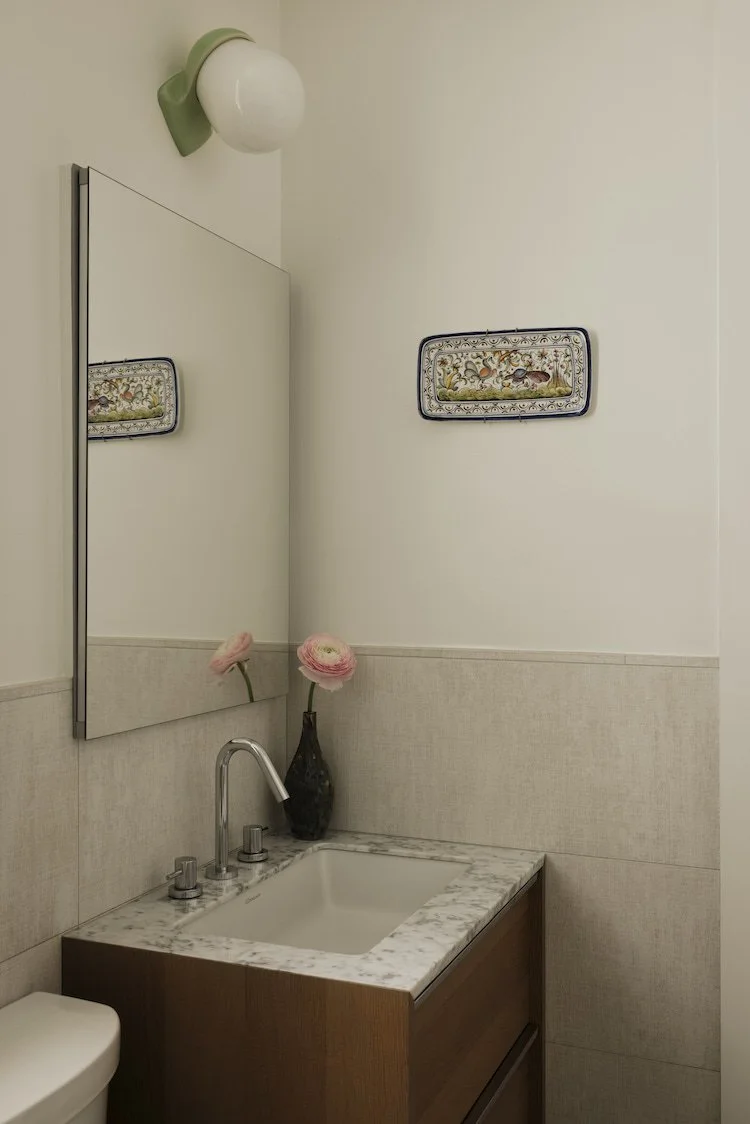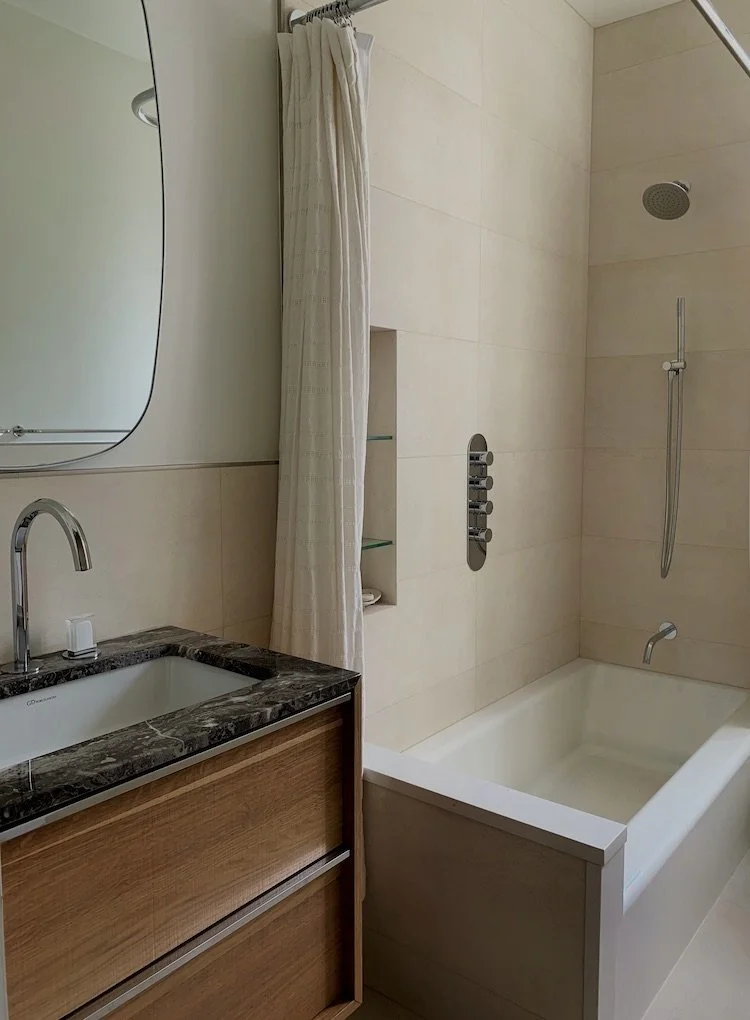A designer’s own space: Inside my classic-meets-modern Manhattan home
Is a designer’s own home ever “done?” Probably not, as we decorators tend to use our own space as our professional laboratories. In my own New York City apartment, I’ve experimented with my evolving style, progressively moving away from color to textured neutrals, and transitioning from a penchant for pure Mid Century Modern to more era-defying pieces that intrigue the eye.
My Upper Manhattan three-bedroom unit is in a 1939 Art Deco building, on the top floor, with views of the Hudson River and the Palisades. The Pre-War proportions are generous, with a central “gallery” space separating the sunken living and dining rooms. Tall ceilings are outlined by simple moldings in the main living spaces, and original oak floors show off classic wood trim.
The renovation was an undertaking. Working with two general contractors, Mark and I opened up walls, gut renovated the kitchen and both bathrooms, removed dark staining from the floors, installed new doors and custom designed baseboards, built new closets, stripped radiator covers down to their original metal, updated the electrical wiring, put in stone windowsills… And each survived some near mental breakdowns.
I can’t help but see things I’d do differently, if I could start the renovation all over again. I wish I had reintroduced vintage 1930s plumbing fixtures back into the 1990s bathrooms, kept more of the ceiling arches, and ditched the kitchen’s white upper cabinets. And there are plenty of furnishings I’d still like to upgrade.
But it’s been a pleasure to live among my revolving mix of vintage furniture and lighting, abstract wall art, Persian rugs, and collectibles that make my space feel like home, even if it’s imperfect. It’s my designer origin story, and I’m excited to share it with you.
Welcome in!
-Ksenya, founder of Time & Place Interiors
Photography by Gloria Kilbourne
Florals by Valentina Spalten
The teak Bernhardt Pedersen credenza was purchased even before the apartment, and thankfully found the right place in the central gallery. Mark unknowingly scored a great eBay find with the 1960s lamp: it’s by the legendary Laurel Lamp Company. On the wall is a 1971 abstract work on canvas. The tabletop sculpture is Italian1980s, and the rug is a vintage Kurdish tribal weave.
In the sunken living room, curves repeat between custom upholstered swivel chairs by Milo Baughman, smoked lucite lamps, and a Post-Modern coffee table. On the wall is a pair of vintage botanical prints I fell in love with at an antiques market in Alexandria. The nesting tables are Florentine.
The glass coffee table allows seamless sight lines through the room and shows off the Moroccan carpet beneath. I love using footstools like this whimsically upholstered ottoman to inject an eclectic accent against more modern furniture. Belgian linen pillows are by Libeco.
My workspace is part of a Mid Century modular shelving unit by Danish fabricator HG Furniture, mounted on the living room wall. The cord lamp is a mini Fog & Mørup model brought over from our last apartment. A pair of blue vases is Portuguese.
I’m constantly redesigning the space in my mind. As I continue to train my design eye, I’m challenging my own interpretation of “modern” style. Nowadays, I seek out more eclectic designs, like this early 1900s Chinese cabinet, which stands out when juxtaposed against the Danish teak furniture it surrounds. I took a chance on the Neoclassical urn watercolor sketch, and am now so glad I didn’t pass it by.
The 1950s Danish teak dining set by Niels Moller is balanced by a refurbished Asian sideboard holding Mark’s liquor and wine collection and topped by an abstract lithograph from the 1960s. To bridge the dining room with the minimal kitchen, I opted for a sleek vintage chrome pendant by Lightolier.
The wall sculpture is an improbable piece of scrap metal, reimagined as wall art, which I spotted at a curiosity dealer’s booth at the Nameless Art Show of found objects.
A Persian runner and wabi-sabi antique jugs give extra texture to the renovated galley kitchen, whose counters are lined with quartz stone. The radiator cover is a repurposed cold air grille — also from architectural salvage.
In a moment of serendipity, I found the pendant light, discarded by a neighbor, while moving into the building.
Art Deco is the theme in the foyer, with the cluster of English mirrors, black glass console shelf, crystal pendant light, and an Afghan rug — all vintage. After decades worth of paint layers were stripped off, I left the front door exposed in its original metal, allowing its sheen to reflect light from the windows across the apartment. Through trial and error, I sourced 1930s door hardware from architectural salvage.
My bedroom’s dressers and nightstands by Robsjohn-Gibbings are Mid Century but have Art Deco style curves. The Brutalist table lamp is from Upstate New York, paired with a RH lampshade. I spotted the gold framed print at an art dealer’s booth in Charlottesville, and later discovered it’s by the 20th Century French artist Camille Bryen. Mark takes credit for the green marble Art Deco clock.
Although it’s not labeled, I suspect the vintage chair’s upholstery is by the famous textile designer Jack Lenor Larsen. The miniature atomic era nightstand lamps were a special gift from Mark. Italian bedding is by Sferra.
I call the funky Mid Century vanity sconce by Sigvard Bernadotte “the platypus.” It matches the vintage jadeite towel bars on the opposite wall of the main bath. Grasscloth textured tile is from Porcelanosa.
The renovation feature I’m most proud of is the Art Deco-style, custom designed baseboards, whose edges progressively taper in depth.
In place of a headboard, I mounted a framed textile from CB2 above the guest bed. The floating teak nightstands are topped by Art Deco table lamps, also from Charlottesville. Mohair pillows by Thomas O’Brien and throw by Mantas Ezcaray echo the vintage Afshar rug’s colors.
I love introducing antiques into nurseries. In place of a standard changing table, I sourced an antique washstand cabinet with excellent storage space. Our girls’ treasured children’s chair with teddy bear upholstery was an irresistible find that unleashed a bidding war and a drive deep into the outer boroughs, but was well worth the effort. The large Persian rug is perfectly stable for play and spills.
In retrospect, I wish I had designed the bathrooms closer in style to the1930s era of the building. But they do feel serene and luxurious. The guest bath’s centerpiece is the Fantini faucet with Murano glass handles.
Interior design services, for New Yorkers seeking a curated space
Time & Place Interiors designs for sophisticated New Yorkers making a fresh start in a new space. Founder Ksenya Malina’s access to one-of-a-kind vintage and cutting edge contemporary designs opens doors for her clients to enjoy living in a bespoke environment, arranged through a seamless start-to-finish luxury service. To discuss your design needs with Ksenya, use the link below schedule a free 20-minute information call:















